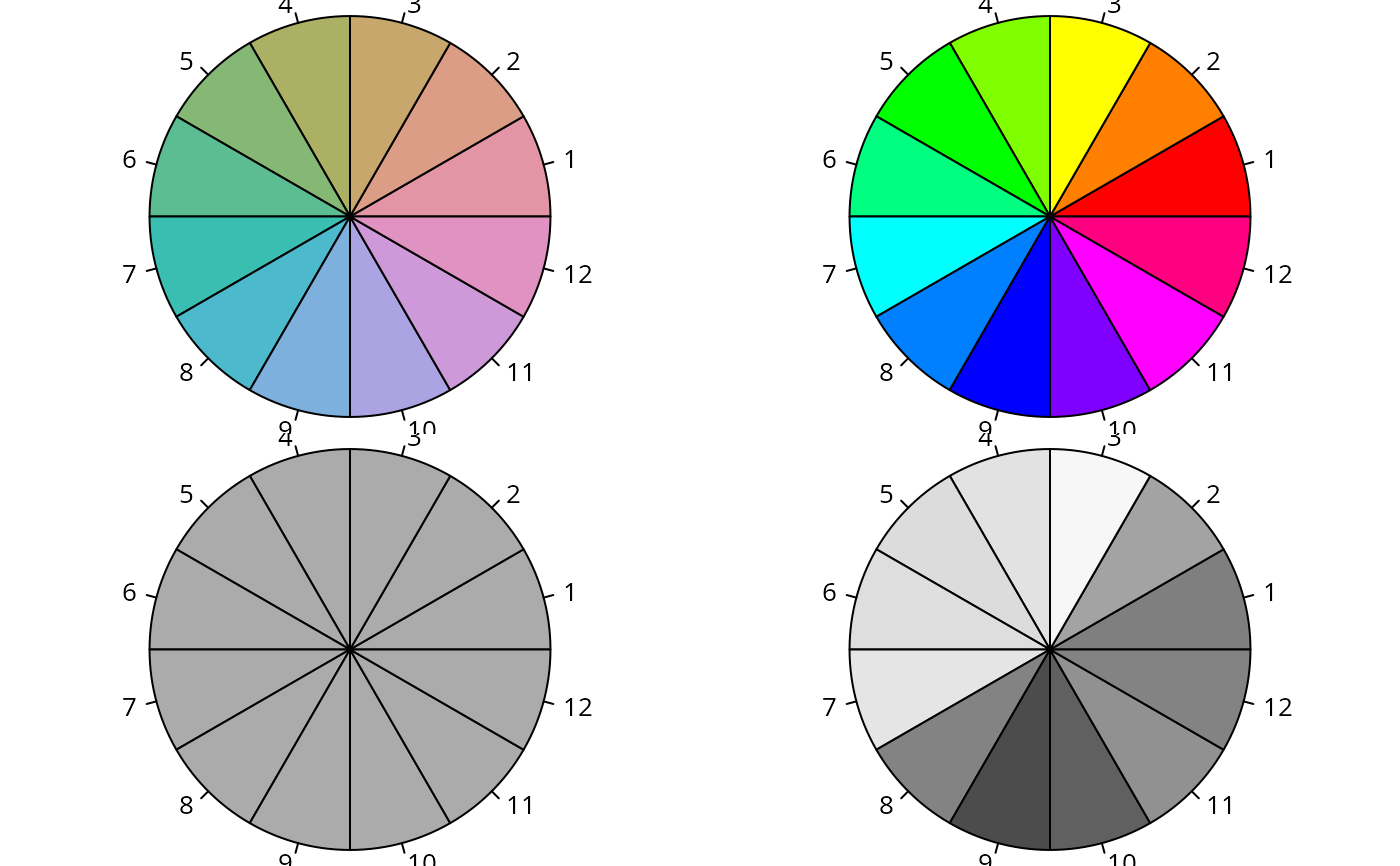Desaturate Colors by Chroma Removal in HCL Space
desaturate.RdTransform a vector of given colors to the corresponding colors with chroma reduced (by a tunable amount) in HCL space.
desaturate(col, amount = 1, ...)Arguments
- col
vector of R colors. Can be any of the three kinds of R colors, i.e., either a color name (an element of
colors), a hexadecimal (hex) string of the form"#rrggbb"or"#rrggbbaa"(seergb), or an integerimeaningpalette()[i]. Additionally,colcan be a formalcolor-classobject or a matrix with three named rows (or columns) containing R/G/B (0-255) values.- amount
numeric specifying the amount of desaturation where
1corresponds to complete desaturation,0to no desaturation, and values in between to partial desaturation.- ...
additional arguments. If
severityis specified it will overrule the input argumentamount(for convenience).
Value
A color object as specified in the input col (hexadecimal string, RGB matrix,
or formal color class) with desaturated colors.
Details
If input col is a vector given colors are first transformed to RGB
(either using hex2RGB or
col2rgb) and then to HCL
(polarLUV). In HCL, chroma is reduced
and then the color is transformed back to a hexadecimal
string.
If input col is a matrix with three rows named R, G, and
B (top down) they are interpreted as Red-Green-Blue values within the
range [0-255]. The desaturation takes place in the HCL space as well.
Instead of an (s)RGB color vector a matrix of the same size as the input
col with desaturated Red-Green-Blue values will be returned.
This can be handy to avoid too many conversions.
Similarly, col can be a formal color-class object, in which
case the desaturated colors are returned as a formal object of the same class as the input.
References
Zeileis A, Fisher JC, Hornik K, Ihaka R, McWhite CD, Murrell P, Stauffer R, Wilke CO (2020). “colorspace: A Toolbox for Manipulating and Assessing Colors and Palettes.” Journal of Statistical Software, 96(1), 1--49. doi:10.18637/jss.v096.i01
Examples
## rainbow of colors and their desaturated counterparts
rainbow_hcl(12)
#> [1] "#E495A5" "#DB9D85" "#C7A76C" "#ABB065" "#86B875" "#5CBD92" "#39BEB1"
#> [8] "#4CB9CC" "#7DB0DD" "#ACA4E2" "#CD99D8" "#E093C3"
desaturate(rainbow_hcl(12))
#> [1] "#ABABAB" "#ABABAB" "#ABABAB" "#ABABAB" "#ABABAB" "#ABABAB" "#ABABAB"
#> [8] "#ABABAB" "#ABABAB" "#ABABAB" "#ABABAB" "#ABABAB"
## convenience demo function
wheel <- function(col, radius = 1, ...)
pie(rep(1, length(col)), col = col, radius = radius, ...)
## compare base and colorspace palettes
## (in color and desaturated)
par(mar = rep(0, 4), mfrow = c(2, 2))
## rainbow color wheel
wheel(rainbow_hcl(12))
wheel(rainbow(12))
wheel(desaturate(rainbow_hcl(12)))
wheel(desaturate(rainbow(12)))
 ## apply desaturation directly on wide RGB matrix (with R/G/B channels in rows)
RGB <- diag(3) * 255
rownames(RGB) <- c("R", "G", "B")
desaturate(RGB)
#> [,1] [,2] [,3]
#> R 127.1223 219.9281 75.94690
#> G 127.1213 219.9264 75.94625
#> B 127.1266 219.9352 75.94962
## apply desaturation directly on wide RGB matrix (with R/G/B channels in rows)
RGB <- diag(3) * 255
rownames(RGB) <- c("R", "G", "B")
desaturate(RGB)
#> [,1] [,2] [,3]
#> R 127.1223 219.9281 75.94690
#> G 127.1213 219.9264 75.94625
#> B 127.1266 219.9352 75.94962